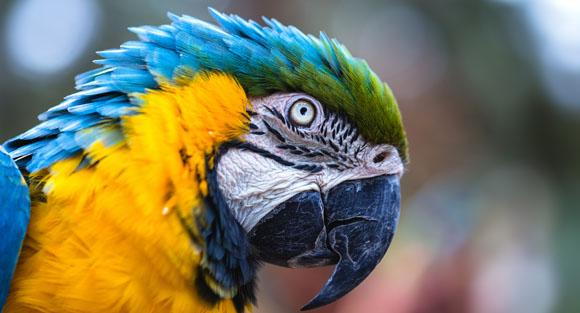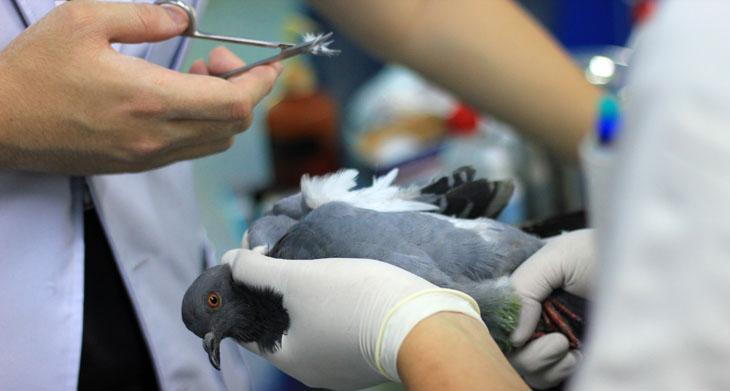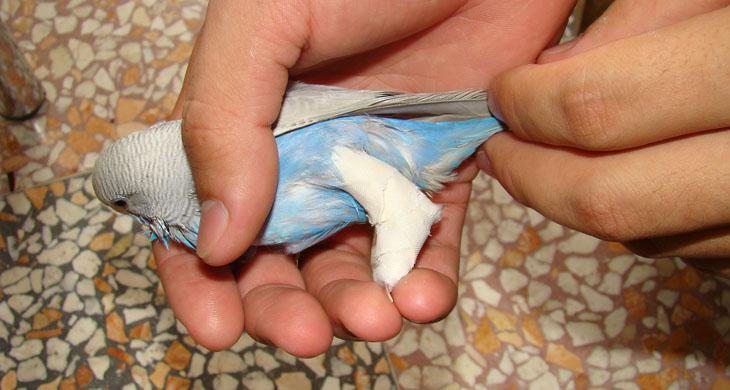Location
Common Avian Emergencies

Whether it's a cockatiel, parrot, parakeet, or another type of pet bird, you know how much joy your feathered friend brings you each day. Because of this, you naturally want to do all you can to make sure your avian friend stays healthy and happy.
Unfortunately, even if you are extremely careful, accidents and emergencies do happen now and then. To make sure you are prepared for an unexpected event that requires veterinarian treatment for your bird, here are the most common avian emergencies and treatments.
Cuts and Wounds

Whether it happens when your bird is in its cage or perhaps when you're letting it fly around parts of your home, various types of cuts and wounds are quite common in such situations. Some common injuries you may encounter with your bird include a chipped beak, broken toenails, or abrasions to its head or legs. Should this occur, it's important that you stay calm since this will help your bird stay calm as well.
To treat these emergencies, an avian veterinarian would typically use gauze to apply pressure to any cuts on your bird. After several minutes, ideally, the bleeding will subside. Once the bleeding stops, the vet will clean the wound with antiseptic. For a broken toenail or chipped beak, treatment will depend upon the extent and nature of the injury. Your veterinarian will send you and your feathered friend home with after-care instructions.
Broken Blood Feathers
If your bird has a broken blood feather, you'll know it because of the visible blood. Since these are young feathers still in the process of growing, their shafts contain blood. Thus, when they break on their own or when you are clipping your bird's wings, you'll need to get the bleeding stopped as soon as you can, and take your bird to the vet. In some cases, the feather may need to be removed. However, never try to treat this common avian emergency at home. Leave this treatment to your avian veterinarian.
Heat Stress
Should you live in an area that is prone to very hot summers, your pet bird may be at risk of suffering heat stress. If left untreated, this can turn into life-threatening heatstroke. This can occur if you have your bird's cage positioned in a spot within your home that gets direct sunlight for many hours each day. Therefore, pay close attention to where you place the cage. Ideally, you should monitor the temperature with a thermostat.
If your bird is suffering from heat stress, the common signs will be panting and holding its wings away from its body. When you see this, it is imperative you get your bird cooled down at once. To do so, move your bird to a place inside your home that is much cooler, then gently mist it with water.
However, don't make the mistake of putting your bird in front of a fan or air conditioner, since this can stress them even more. You should cool down your bird in subtle degrees. Once you've done this, give them access to clean, fresh water and closely monitor them for any additional signs of heat stress. Finally, contact your veterinarian and explain your situation to see if your bird needs to undergo an examination.
Broken Wing

A broken wing is an avian emergency that can occur when your bird crashes into something while flying around. This will require immediate veterinary care. Otherwise, your bird may lose the use of its wing and essentially be crippled.
Rather than have this happen, stay calm and do all you can to keep your bird calm as well. Then, grab elastic bandaging tape and use it to lightly wrap your bird, making sure the broken wing can't be moved around so that further injury does not take place on the way to the vet. Once you've got your bird wrapped, transport it to your veterinarian for prompt treatment.
Domestic Pet Attack
If you have other pets in your home such as dogs or cats, you need to be extra careful to make sure they are not able to attack your bird. In some cases, bites or scratches can occur even if your bird and the other pets are on good terms. As you know, gentle play can often turn into roughhousing with pets.
One of the most common injuries that can turn into an emergency is when your cat paws at your bird with its claws extended. Since these pricks can be small, you may not initially notice them. However, these wounds can get infected quickly, often as soon as overnight.
If you notice your bird not eating, drinking more water than usual, and having less and less energy, take your bird to the vet immediately. Often, a simple course of antibiotics is all that's needed to help your bird fully recover.
Entanglement
When you watch your pet bird when it's relaxing and playing, you'll notice it has a real fondness for its toys, in particular any made out of rope or cloth. However, since your bird loves these toys so much, they can quickly become frayed. In some cases, birds get entangled within their toys. In the struggle to free themselves, they can injure their wings, beaks, legs, or other parts of their body.
If this happens, try to gently free them from the entanglement. Since it's possible that they could suffer a broken toenail, injure their wing, or even cause a sprain while entangled, don't assume all is okay once you get them free. To be on the safe side, bring them in for a vet exam to ensure that no injuries occurred.
Whether your bird suffers a broken wing, gets too hot on a summer day, or accidentally gets hurt while playing, remember that your avian vet is fully equipped to handle all kinds of avian emergencies. By having your bird examined and treated by a veterinarian as quickly as you can, chances are you and your bird will enjoy many more happy years together.

Whether it's a cockatiel, parrot, parakeet, or another type of pet bird, you know how much joy your feathered friend brings you each day. Because of this, you naturally want to do all you can to make sure your avian friend stays healthy and happy.
Unfortunately, even if you are extremely careful, accidents and emergencies do happen now and then. To make sure you are prepared for an unexpected event that requires veterinarian treatment for your bird, here are the most common avian emergencies and treatments.
Cuts and Wounds

Whether it happens when your bird is in its cage or perhaps when you're letting it fly around parts of your home, various types of cuts and wounds are quite common in such situations. Some common injuries you may encounter with your bird include a chipped beak, broken toenails, or abrasions to its head or legs. Should this occur, it's important that you stay calm since this will help your bird stay calm as well.
To treat these emergencies, an avian veterinarian would typically use gauze to apply pressure to any cuts on your bird. After several minutes, ideally, the bleeding will subside. Once the bleeding stops, the vet will clean the wound with antiseptic. For a broken toenail or chipped beak, treatment will depend upon the extent and nature of the injury. Your veterinarian will send you and your feathered friend home with after-care instructions.
Broken Blood Feathers
If your bird has a broken blood feather, you'll know it because of the visible blood. Since these are young feathers still in the process of growing, their shafts contain blood. Thus, when they break on their own or when you are clipping your bird's wings, you'll need to get the bleeding stopped as soon as you can, and take your bird to the vet. In some cases, the feather may need to be removed. However, never try to treat this common avian emergency at home. Leave this treatment to your avian veterinarian.
Heat Stress
Should you live in an area that is prone to very hot summers, your pet bird may be at risk of suffering heat stress. If left untreated, this can turn into life-threatening heatstroke. This can occur if you have your bird's cage positioned in a spot within your home that gets direct sunlight for many hours each day. Therefore, pay close attention to where you place the cage. Ideally, you should monitor the temperature with a thermostat.
If your bird is suffering from heat stress, the common signs will be panting and holding its wings away from its body. When you see this, it is imperative you get your bird cooled down at once. To do so, move your bird to a place inside your home that is much cooler, then gently mist it with water.
However, don't make the mistake of putting your bird in front of a fan or air conditioner, since this can stress them even more. You should cool down your bird in subtle degrees. Once you've done this, give them access to clean, fresh water and closely monitor them for any additional signs of heat stress. Finally, contact your veterinarian and explain your situation to see if your bird needs to undergo an examination.
Broken Wing

A broken wing is an avian emergency that can occur when your bird crashes into something while flying around. This will require immediate veterinary care. Otherwise, your bird may lose the use of its wing and essentially be crippled.
Rather than have this happen, stay calm and do all you can to keep your bird calm as well. Then, grab elastic bandaging tape and use it to lightly wrap your bird, making sure the broken wing can't be moved around so that further injury does not take place on the way to the vet. Once you've got your bird wrapped, transport it to your veterinarian for prompt treatment.
Domestic Pet Attack
If you have other pets in your home such as dogs or cats, you need to be extra careful to make sure they are not able to attack your bird. In some cases, bites or scratches can occur even if your bird and the other pets are on good terms. As you know, gentle play can often turn into roughhousing with pets.
One of the most common injuries that can turn into an emergency is when your cat paws at your bird with its claws extended. Since these pricks can be small, you may not initially notice them. However, these wounds can get infected quickly, often as soon as overnight.
If you notice your bird not eating, drinking more water than usual, and having less and less energy, take your bird to the vet immediately. Often, a simple course of antibiotics is all that's needed to help your bird fully recover.
Entanglement
When you watch your pet bird when it's relaxing and playing, you'll notice it has a real fondness for its toys, in particular any made out of rope or cloth. However, since your bird loves these toys so much, they can quickly become frayed. In some cases, birds get entangled within their toys. In the struggle to free themselves, they can injure their wings, beaks, legs, or other parts of their body.
If this happens, try to gently free them from the entanglement. Since it's possible that they could suffer a broken toenail, injure their wing, or even cause a sprain while entangled, don't assume all is okay once you get them free. To be on the safe side, bring them in for a vet exam to ensure that no injuries occurred.
Whether your bird suffers a broken wing, gets too hot on a summer day, or accidentally gets hurt while playing, remember that your avian vet is fully equipped to handle all kinds of avian emergencies. By having your bird examined and treated by a veterinarian as quickly as you can, chances are you and your bird will enjoy many more happy years together.
Monday
9:00 am - 5:00 pm
Tuesday
9:00 am - 5:00 pm
Wednesday
9:00 am - 5:00 am
Thursday
9:00 pm - 5:00 am
Friday
9:00 pm - 5:00 am
Saturday
Closed
Sunday
Closed
